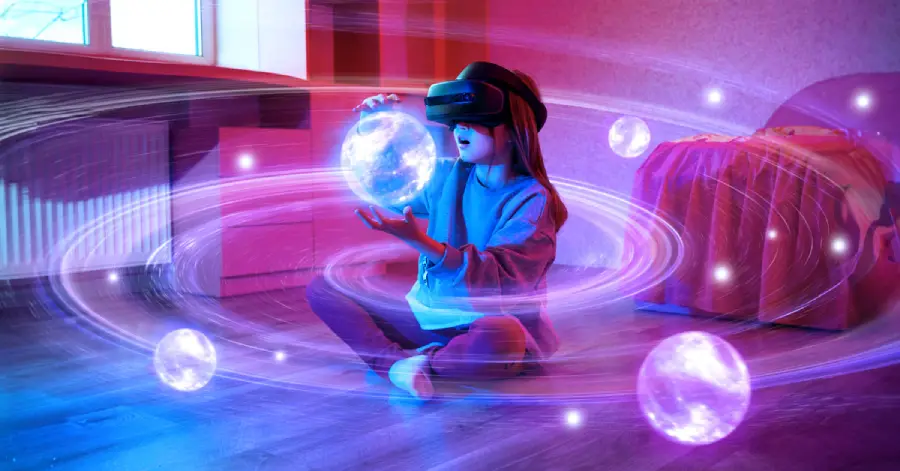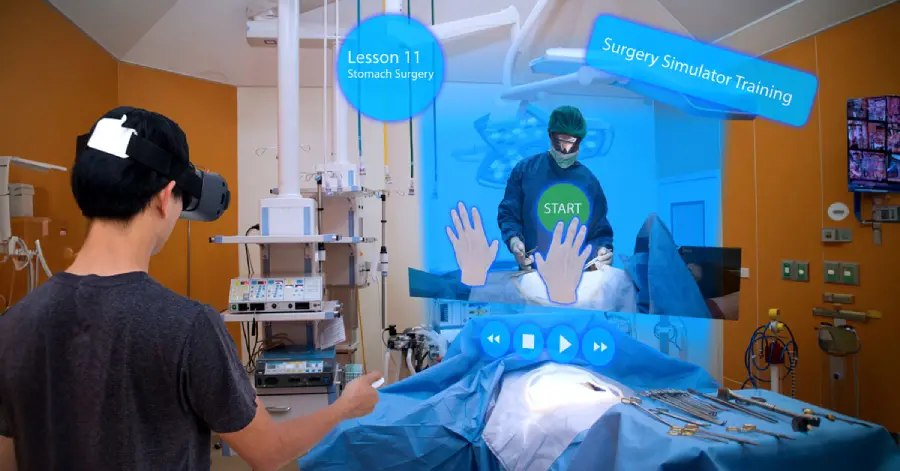How Is VR In Education Enhancing Learning Efficiency?
- Published on: April 2, 2024
- |
- Updated on: April 7, 2024
- |
- Reading Time: 12 mins
- |
-
Views
- |
Introduction
Benefits of VR in Education
Offers an Enriching Learning Environment
Enhancing Knowledge Memorization
Generates Better Learning Outcomes
Nurturing Social and Collaborative Skills
Developing an Empathetic Attitude
Applications of VR Learning
VR Is Empowering Special Educational Needs Disabilities
Vocational Training Through VR
Medical Simulation Through VR
Quick Decision Tree
How VR Enhances Classroom Experience
Providing Students With Personalized Learning Opportunities
Motivating Students Towards Lifelong Learning
Offering Flexibility to the Classroom Establishments
Implementing VR In Different Subjects
Mathematics
Science
Geography
History
Technology
Future Trends of VR in Education
Conclusion
FAQs
Introduction
Virtual reality in education enables educators to create a virtually simulated environment for students to learn by interacting with the virtually fabricated environment and understanding complex concepts easily. This virtual environment can be accessed by students through VR headsets, lenses, and 360-degree virtual surroundings for immersive viewing.
According to the 2022 report published by the National Research Group on VR, 61% of customers think VR and AR are beneficial learning tools for children.
Another poll conducted by ISTE and XRA revealed that 67% of US high school educators feel that extended reality technologies like VR should be used regularly in schools. The majority of educators believe that technologies like VR have the capabilities to help students build their career skills and empathy skills, as well as motivate and engage the students in the classroom.
Benefits of VR in Education
VR in education has substantially benefited students across the globe. A study by the University of Maryland found that median recall accuracy rates were 90%, as against 78%, through regular desktop computers. Now, to shed some light on why VR in education has benefited students, here are a few benefits that justify this change in students’ learning ways:
1. Offers an Enriching Learning Environment
Virtual reality provides students with engaging learning experiences, which enables them to memorize what they have read more comprehensively. It also drives them to learn and explore deeply. Students can view far-off planets, moons, and the orbital motion of planets just by sitting in a classroom with an exciting blend of immersive and interactive environments that triggers an increased curiosity in them. This leads to an increased interest in learning.
VR, through an interactive environment, creates a tangible and hands-on experience that enables the students to not only have a good grasp of the information but also get a real-life idea about how a certain thing operates and how it’s done practically.
Additionally, VR also provides a safe and supportive environment for students to express their ideas freely and actively participate in knowledge acquisition. For instance, students can do science experiments without worrying about any potential risks or harm.
A study by Standford researchers revealed that learners who took part in VR field trips for climate change developed a deeper cognitive establishment with the scientific content. Moreover, they could learn, reminisce, and remember the causes and effects of acidified oceans, leading to an improved understanding than someone who didn’t physically explore it.
According to research, when VR-based learning was compared to conventional, textbook, and video-based learning, it was observed that students could recollect the information even after weeks of learning it and scored higher compared to the textbook and video-based learning. Moreover, the confidence of students increased as well during the tests conducted during the research.
All this happened due to an immersive and interactive learning experience that enhances students’ understanding of the concepts and emotionally connects them with them, captivating them to learn more.
VR in education is innovating the learning experience for students with immersive viewing of subjects for a better grasp of the theoretical aspects of diverse subjects. By bridging the gap between conception and practicality, VR has the potential to develop a willingness towards lifelong learning.
As more and more educational institutions move towards VR, VR can become a crucial component of the education system since it eliminates mobility and knowledge acquisition constraints, resulting in a more feasible, simpler, and convenient manner.
2. Enhancing Knowledge Memorization
With VR in play, students can get clarity on all the subject matters with a proper audio-visual experience that offers them a comprehensive sensory experience. This sensory experience enables in-depth learning among the students, leading to higher knowledge retention. In fact, as per the researchers of the Virtual Reality journal, people tend to retain information in virtual environments in a much better way.
Another research study by the University of Maryland showed that participants with a VR headset were more confident and encountered fewer errors compared to desktop-based learning. This resulted in better knowledge memorization and higher accuracy among students.
The average recall among the participants was 8.8% higher than the desktop-based learning. Meanwhile, the recall accuracy percentage was 84.05%, while desktop learning was 75.24%. Recall accuracy measured the occurrence of correct answers and the number of learners who made the recall error during the entire research study.
3. Generates Better Learning Outcomes
Educational institutions with VR can achieve significant cost-effectiveness by eliminating the need for physical peripherals required for educational training in schools and colleges. For instance, the Icahn School of Medicine witnessed an 83% decline after using VR for advanced cardiac life support (ACLS) training. Virtual reality also enables schools to decrease the time spent by students in educational training substantially. The engrossing way in which VR allows students to concentrate and immerse themselves in the learning material results in quick knowledge acquirement and skill enhancement. For example, PwC discovered that through VR, learners took 29 minutes to learn, while classroom learners took 2 hours to complete the same training.
Virtual reality improves student learning outcomes by providing them with tactile and immersive experiences combined, leading to a pragmatic understanding of the concepts and helping them achieve their outcomes. In fact, as per the research by the University of Maryland in Beijing, students who completed their lessons with VR attained average scores of 93 in the final exam, leading to a 20% point hike from traditional classroom learning.
4. Nurturing Social and Collaborative Skills
VR helps boost teamwork and elevates the social skills of the students by curating an engaging and synergistic learning environment that allows them to collaborate in real time, work on group projects, and solve problems together virtually.
Virtual reality also enables students to nurture cultural inclusivity in students by developing a sense of awareness, appreciation, and respect towards diverse cultures and beliefs. Through VR, students are also able to interact with the digital avatars of their mates, where body language, audio, and other humanistic components are applied.
5. Developing an Empathetic Attitude
Educators, through VR, can instill empathy in students by making them explore diverse cultures and step into the lives of people from different countries and continents around the globe. This makes it possible for the students to experience the life situations and emotions of other communities.
For instance, VR has the capability to make students observe and feel the climactic effects on susceptible community struggles of refugees and immigrants to relate to the situations of those who are discriminated against and oppressed. By bringing their interest towards these kinds of scenarios, VR can trigger an emotional response from them, question their presumptions, and understand the plight of the oppressed sections of societies.
Applications of VR Learning
Multiple learning applications of VR have been in use for quite some time. Here are a few of them that enable educators to educate students to learn in a better way:
1. VR Is Empowering Special Educational Needs Disabilities
One of the most crucial applications that VR assists in is empowering students with disabilities who might be able to access the learning content meant for general use. To tackle this, VR has made it possible for teachers/educators to curate personalized learning content as per their distinctive requirements.
2. Vocational Training Through VR
Another application of VR is to train students for the professional world by simulating workplace environments virtually. Students can choose their dream job and learn about its different aspects. They can familiarize themselves with the mannerisms of a workplace and an idea about the workplace environment.
For instance, law students can be given the task of finding clues about a case in a virtual environment. Each clue will come with certain scores, and the educators can assess the student’s performance.
The best thing about doing vocational training in VR is that students can learn at their own pace and grow themselves by solving complex real-world tasks easily with interaction and not having to worry about its consequences.
3. Medical Simulation Through VR
The medical field is crucial, and any mistake here can cost someone their life. Now, to tackle it, VR is there, where medical students can train themselves by simulating real-life medical operations. This helps them identify the critical components of medical procedures, evaluate their mistakes, view their repercussions, and rectify them right away and all this in real-time.
4. Quick Decision Tree
Students can learn about the decision tree through VR in an intriguing way. A decision tree comes from the storyboard. A decision tree is a story with distinctive endings.
Through VR, students can make decisions based on different choices in a given situation and view what kind of ending it leads to. This not only helps students make good decisions but also enables them to identify the criteria on which they can make a decision.
How VR Enhances Classroom Experience
VR assists students in learning through pragmatic experience. It replicates real-world scenarios into a VR-enabled device and enables the students to understand the subject matter and relate to it in a meaningful way.
Through VR, students can explore beyond the restrictions of the subjects taught in their classroom and prepare for the career path they hope to pursue. Here are some best practices that you can follow to enhance your classroom experience as an educator:
1. Providing Students With Personalized Learning Opportunities
Virtual reality helps educators customize the students’ learning experiences to meet their needs and provide distinctive learning methods. It adapts to the learning pace of an individual student and provides dedicated feedback.
For instance, students can practice mathematical problems at their own pace, and VR gradually adjusts to their academic progress and gives feedback accordingly.
2. Motivating Students Towards Lifelong Learning
VR creates a sense of curiosity and eagerness towards learning more by making it an enriching learning experience.
For example, educational establishments provide spray painting courses, where innovative tools such as virtual reality spray painting systems are employed. This creates an ecosystem where students can practice, make mistakes, and correct them to improve their skill set in real-life situations.
By creating such an immersive environment through VR, educators motivate students to learn pragmatic skills that prepare them for their dream job.
3. Offering Flexibility to Classroom Establishments
There are different types of classroom settings where educators educate the students through different modes of learning. Now, here comes VR into play that adapts to varied learning environments and helps in educating students more effectively and efficiently.
For instance, geography students can learn about different parts of the globe with an apt VR framework constructed either in the classroom or through distance learning in an interactive and immersive manner.
Implementing VR In Different Subjects
Mathematics
Mathematics is one of the pillars of a student’s growing years and even when they grow up. However, maths can sometimes get a bit complicated for students and teachers. Here enters VR that educators can inculcate into their classes to ease the understanding of complex calculations like the probability of compound events in 7th grade, PEDMAS in 5th grade, and division in 3rd grade.
Science
Science fosters critical thinking and problem-solving skills in pupils and is much needed in today’s day and age. With VR implemented, students can grasp complex science concepts from the textbook. It can zoom into the activities of cells, dive into the skeletal system, and show how the human heart pumps blood through the circulatory system.
Geography
Learning geography manually through books and tracking the maps could be challenging for students. However, teachers can educate students by taking them on virtual tours through VR, not just showing them Mount Everest or the Mariana Trench but also giving them a deeper understanding of climate, land formations, water bodies, and natural resources.
History
History helps in connecting with the origins of diverse cultures and civilizations, which have evolved and shaped us in some shape or form. Hence, having a good knowledge about it is imperative for the students. Through VR, students can explore places of historical significance and cultural sites, leading to a deeper and more meaningful understanding of history. For instance, Egyptian pyramids or Roman architecture.
Technology
Having a good understanding of technology these days is a must because of its omnipresence across the globe and continuous evolution over time. Here comes VR, through which students can hold a grasp of not only the subjective knowledge of technology but also how it works and what its components are. VR enables students to interact with the technology being explained and learn while experiencing it practically.
Future Trends of VR in Education
There is no doubt that education is evolving at a rapid pace with the help of technological upgradation and one such advancement is VR, which is gradually getting integrated with education and is enhancing the overall learning experience amongst students. However, educators need to identify the futuristic impact of VR in education. So let’s dive deep into the future trends of VR in education:
- VR-based education is expected to become a $700 million industry by 2025 and will be the 4th biggest sector to invest in VR, which means that VR in education has the potential to witness higher chunks of investments.
- Personalized learning through VR is going to change the role of teachers, where students will be able to learn at their own pace, while teachers will act more as facilitators to guide them, answer their questions, and give apt feedback. In fact, as per a survey conducted by the Education Week Research Center, 80% of teachers feel that technologies like VR will change their role as teachers in the classroom.
- Another new approach that’s gaining considerable traction in higher education is competency-based education, where students will be assessed on their mastery of a certain concept or skill. There are around 600 colleges or universities in the US that are offering competency-based programs.
Conclusion
All in all, VR in education seems promising and is expected to empower many educational institutions and produce some good talent across the global landscape.
With VR getting new upgrades in the form of personalized learning and new programs like competency-based programs getting integrated with it, educating students has become easy for educators across the globe aided by technological integration. Similarly, students are also able to learn at their own pace, get real-time feedback, understand their learning levels, and quickly improve themselves.
As we saw above, the future of VR in education seems very promising and can ease the hard work of teachers and students, and here we have barely scratched the surface of VR in education. Hence, generative AI and machine learning being integrated into VR can make VR-based learning more dynamic and engaging.
FAQs
The affordability and accessibility of VR technology for educational institutions and students vary widely. It depends on factors such as the type of VR equipment required, available resources, and geographical location. While some institutions may have the budget to invest in VR headsets and software, others may struggle to afford them. Additionally, disparities in internet access and technological infrastructure can further impact accessibility, especially in regions with limited resources.
Potential drawbacks or limitations of using VR in education are the initial cost of equipment and software, health and safety risks associated with prolonged use of VR headsets, and the need for adequate training to educate educators about effectively integrating their teaching practices.
Educators may also face challenges in finding suitable VR content that aligns with their curriculum and learning objectives.
Comparative studies or data evaluating the long-term educational outcomes of students taught using VR versus traditional methods are limited but increasingly being conducted. While some of the researches suggest that VR can enhance learning outcomes and retention rates, further studies are needed to explore the effectiveness of VR across different subjects, age groups, and educational settings.
Educators are being trained to integrate VR into their teaching practices through professional development programs, workshops, and online courses offered by educational institutions, technology companies, and professional organizations.
Ongoing support is also available through forums, communities, and resource centers where educators can exchange ideas, share best practices, and troubleshoot issues related to VR implementation.

Get In Touch
Reach out to our team with your question and our representatives will get back to you within 24 working hours.


